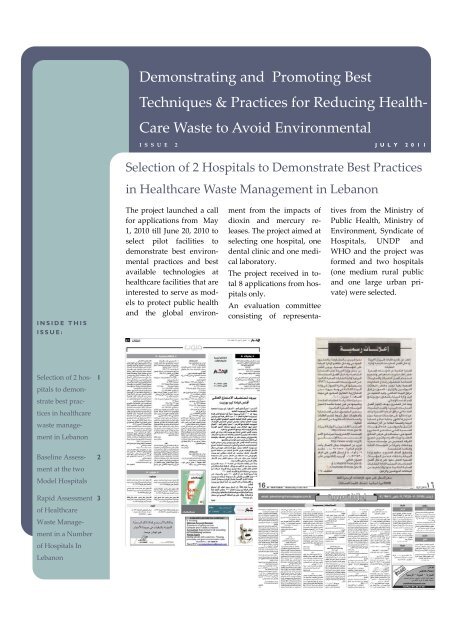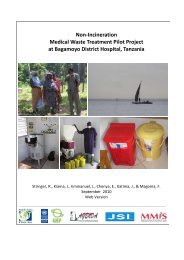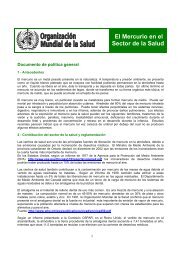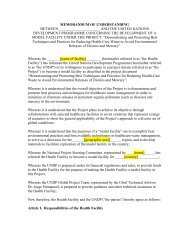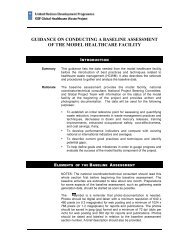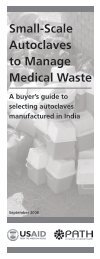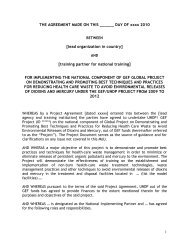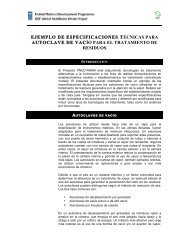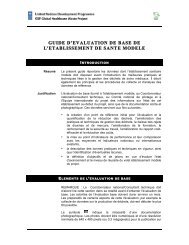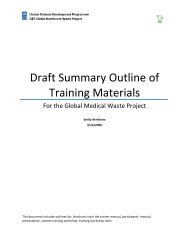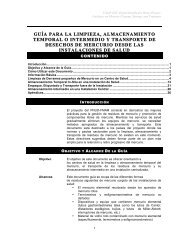Newsletter- Issue 2 f - UN/GEF Global Healthcare Waste Project
Newsletter- Issue 2 f - UN/GEF Global Healthcare Waste Project
Newsletter- Issue 2 f - UN/GEF Global Healthcare Waste Project
Create successful ePaper yourself
Turn your PDF publications into a flip-book with our unique Google optimized e-Paper software.
Demonstrating and Promoting Best<br />
Techniques & Practices for Reducing Health‐<br />
Care <strong>Waste</strong> to Avoid Environmental<br />
I S S U E 2<br />
J U L Y 2 0 1 1<br />
Selection of 2 Hospitals to Demonstrate Best Practices<br />
in <strong>Healthcare</strong> <strong>Waste</strong> Management in Lebanon<br />
INSIDE THIS<br />
ISSUE:<br />
The project launched a call<br />
for applications from May<br />
1, 2010 till June 20, 2010 to<br />
select pilot facilities to<br />
demonstrate best environmental<br />
practices and best<br />
available technologies at<br />
healthcare facilities that are<br />
interested to serve as models<br />
to protect public health<br />
and the global environment<br />
from the impacts of<br />
dioxin and mercury releases.<br />
The project aimed at<br />
selecting one hospital, one<br />
dental clinic and one medical<br />
laboratory.<br />
The project received in total<br />
8 applications from hospitals<br />
only.<br />
An evaluation committee<br />
consisting of representa‐<br />
tives from the Ministry of<br />
Public Health, Ministry of<br />
Environment, Syndicate of<br />
Hospitals, <strong>UN</strong>DP and<br />
WHO and the project was<br />
formed and two hospitals<br />
(one medium rural public<br />
and one large urban private)<br />
were selected.<br />
Selection of 2 hospitals<br />
to demonstrate<br />
best practices<br />
in healthcare<br />
waste management<br />
in Lebanon<br />
1<br />
Baseline Assessment<br />
at the two<br />
Model Hospitals<br />
Rapid Assessment<br />
of <strong>Healthcare</strong><br />
<strong>Waste</strong> Management<br />
in a Number<br />
of Hospitals In<br />
Lebanon<br />
2<br />
3
PAGE 2<br />
Baseline Assessment at the Two Model Hospitals<br />
Mixing of segregated<br />
healthcare<br />
waste during final<br />
storage<br />
ʺ“Knowing is<br />
not enough; we<br />
must apply.<br />
Willing is not<br />
enough; we<br />
must do.”<br />
—Goethe<br />
A baseline assessment was<br />
conducted at the two model<br />
facilities in order to:<br />
• Establish an initial reference<br />
point for assessing<br />
and quantifying waste<br />
reduction, improvements<br />
in waste management<br />
practices and techniques,<br />
decreases in dioxin and<br />
mercury releases, training<br />
improvements, enhanced<br />
occupational safety, costeffectiveness,<br />
and cost<br />
savings, if any;<br />
• Develop performance<br />
indicators and compare<br />
with existing national or<br />
international indicators<br />
and averages;<br />
• Describe current good<br />
practices and techniques<br />
and identify potential<br />
gaps;<br />
• Help define goals and<br />
milestones to gauge progress<br />
and evaluate the<br />
success of the model facility<br />
component of the project.<br />
The results of the baseline<br />
assessment came as follows:<br />
• None of the hospitals<br />
have a person or a committee<br />
in charge of healthcare<br />
waste management.<br />
• Some policies and procedures<br />
are available for<br />
waste collection and<br />
transport but these need<br />
to be more comprehensive<br />
and complemented<br />
by other procedures.<br />
• The hospitals have a color<br />
‐coding system and the<br />
basic equipments for<br />
waste segregation. Unfortunately<br />
at both hospitals<br />
bins distribution among<br />
departments was not performed<br />
based on a needs’<br />
assessment. And waste<br />
containers were not labeled<br />
according to the<br />
waste categories.<br />
• <strong>Waste</strong> storage areas are<br />
not available in all departments.<br />
And those available<br />
weren’t compliant<br />
with international requirements.<br />
• Inspection rounds were<br />
conducted for 3 days to<br />
examine segregation practices.<br />
The results varied<br />
between 96% and 100% of<br />
poor segregation between<br />
the two hospitals.<br />
• <strong>Healthcare</strong> waste at the<br />
two hospitals are mixed<br />
all together at the final<br />
storage area and picked<br />
up by the municipalities<br />
for final disposal without<br />
prior treatment.<br />
• <strong>Waste</strong> weighing was conducted<br />
at both hospitals<br />
for a period ranging between<br />
14 and 21 days.<br />
Associated results were<br />
summarized in table below.<br />
• The average recurring<br />
monthly cost for waste<br />
management ranged between<br />
USD 5,000 and<br />
USD 20,500 corresponding<br />
to USD 6 and 11 USD<br />
per patient.<br />
• Mercury waste generated<br />
at both hospitals as a result<br />
of thermometers and<br />
fluorescent lights usage.<br />
The percentage of broken<br />
thermometers ranged<br />
between 3 and 4.5% of the<br />
total number of purchased<br />
thermometers per<br />
year. The hospitals don’t<br />
have any policies and<br />
procedures related to<br />
management and disposal<br />
of mercury containing<br />
products or mercury<br />
spills. Current practices in<br />
the event of thermometer<br />
breakage involves collection<br />
of the glass and mercury<br />
in sharps boxes to be<br />
disposed of with different<br />
types of wastes.<br />
After the completion of the<br />
baseline assessment, planning<br />
for healthcare waste<br />
management in the two<br />
model facilities was initiated<br />
with the formation of<br />
healthcare waste management<br />
committees.<br />
Recapping<br />
of needles<br />
placed in<br />
sharp containers<br />
Indicator<br />
Average total waste generation rate in kg per occupied<br />
bed per day<br />
Average infectious waste generation rate in kg per<br />
bed per day<br />
Average percentage of infectious waste from total<br />
waste (%) 37.3<br />
Hospital<br />
1<br />
Hospital<br />
2<br />
Bench<br />
Mark<br />
3.09 5.3 0.8‐ 6<br />
1.07 1.15 0.3‐0.4<br />
39 37 16%
ISSUE 2<br />
PAGE 3<br />
Rapid Assessment of <strong>Healthcare</strong> <strong>Waste</strong> Management (HCWM) in a<br />
Number of Hospitals In Lebanon<br />
The project team in collaboration with students from the Lebanese University conducted a rapid<br />
assessment for healthcare waste management in around 48 hospitals (46 private and 2 public hospitals).<br />
The average number of beds in these hospitals was around 112 beds with an average occupancy rate of<br />
63%. The average score of the rapid assessment was 57%. Results of the Rapid Assessment were as follows:<br />
Organizational Structure<br />
• Around 83% of the hospitals have a person in charge of<br />
HCWM, while only 54% have a committee dealing with<br />
HCWM;<br />
Financing<br />
• Around half of the hospitals don’t have a financing plan<br />
for sustainable health care management as shown in below<br />
Graph.<br />
Policies and Procedures<br />
• 96% of the hospitals have written policies and procedures<br />
related to HCWM;<br />
• Only 17% of the hospitals are mercury free.<br />
Training<br />
• 31% of the hospitals have a training program on health<br />
care waste management targeting all working groups;<br />
• 88% hospitals train their newly recruited staff on HCWM<br />
and only 77% conduct yearly refresher training sessions<br />
for all staff.<br />
Occupational Safety<br />
• Only 82% of hospitals provide personal protective equipments<br />
to staff handling waste;<br />
• Necessary vaccination is provided to staff exposed to occupational<br />
risks through healthcare waste handling in<br />
72% of the surveyed facilities.<br />
Example of personal protective equipments<br />
used during waste handling<br />
ʺʺGrowth for the sake of growth is the ideology of the cancer cell.ʺ— Edward Abbey
PAGE 4<br />
Rapid Assessment of <strong>Healthcare</strong> <strong>Waste</strong> Management<br />
in a Number of Hospitals In Lebanon<br />
<strong>Healthcare</strong> <strong>Waste</strong> Management Practices<br />
Classification<br />
and Segregation:<br />
• Staff are familiar with the healthcare waste classification<br />
in 68% of the facilities. While waste is properly<br />
segregated in only 42% of facilities.<br />
Color Coded<br />
Wheeled <strong>Waste</strong> Bins<br />
Generation<br />
Data:<br />
• More than 90% of hospitals generate infectious, hazardous<br />
and special wastes.<br />
• <strong>Waste</strong> weighing is only common in 37% of the hospitals.<br />
In those hospitals infectious waste was estimated<br />
around 20% of the total waste.<br />
Collection<br />
Handling:<br />
&<br />
• Around 50% of the hospitals use low density plastic<br />
waste bags and don’t train their waste workers for accidental<br />
spills management.<br />
"In the long<br />
term, economic<br />
sustainability<br />
depends on<br />
ecological<br />
sustainability.ʺ<br />
—<br />
“America’s<br />
Living<br />
Oceans<br />
[Pew<br />
Oceans<br />
Report,<br />
2003]<br />
Color Coding<br />
and Labeling:<br />
Internal Transport<br />
As a General Practice, hospitals<br />
transport the waste in<br />
a closed and clean transport<br />
cart away from patient areas<br />
as shown in graph.<br />
• 58% of facilities use a system of color coding for different<br />
type of waste.<br />
<strong>Waste</strong> Storage Areas<br />
Only 16% hospitals have<br />
storage areas that meet the<br />
proper requirements as<br />
shown in Graph.<br />
Improper <strong>Waste</strong><br />
Storage Area
ISSUE 2<br />
PAGE 5<br />
Rapid Assessment of <strong>Healthcare</strong> <strong>Waste</strong><br />
Management in a Number of Hospitals In Lebanon<br />
<strong>Waste</strong> Treatment and Disposal:<br />
• 53% of facilities treat it<br />
infectious waste prior<br />
to disposal;<br />
• 32% of the hospitals<br />
adopted some kind of<br />
treatment technologies<br />
on site as opposed to<br />
10% treating in off‐site<br />
center .<br />
• 9% of the hospitals are<br />
still using incineration<br />
technologies, although<br />
these are not licensed<br />
by the Ministry of the<br />
Environment.<br />
<strong>Waste</strong>water Treatment<br />
• Only 12% of healthcare<br />
facilities treat their<br />
wastewater before being<br />
released into the<br />
main sewer network..<br />
Non‐burn healthcare waste<br />
treatment technology<br />
Mercury Use<br />
Around 84 % of the surveyed hospitals are still using mercury containing products, mainly mercury<br />
containing thermometers and sphygmomanometers. Other mercury containing products generally used<br />
include items listed in table below.<br />
Product type used<br />
Percentage of<br />
hospitals<br />
Dental amalgam 5%<br />
Gastrointestinal tubes (Cantor tubes, esophageal dilators, Miller‐Abbott<br />
35%<br />
tubes)<br />
Phenyl mercuric acetate preservative 8%<br />
Mercury‐containing stains 25%<br />
Thermostat probes 27%<br />
Barometers 18%<br />
Fluorescent tubes 55%<br />
Others (specify) 12.5%<br />
Spilled Mercury is considered<br />
a serious health risk<br />
due to the physical characteristic<br />
of the compound<br />
and its toxic properties.<br />
Although the majority of hospitals are aware of the health risks associated with<br />
the use of mercury and have mercury spill clean‐up and disposal policies and<br />
procedures, only 17% are ready to become mercury‐free without financial<br />
assistance, while 67% showed interest in phasing out mercury in the presence of<br />
financial assistance.
<strong>Project</strong> Objectives:<br />
Demonstrating Best Techniques and<br />
Practices for Reducing Health Care <strong>Waste</strong><br />
to Avoid Environmental Releases of<br />
Dioxins and Mercury<br />
Ministry of Environment<br />
Lazarieh Bldg., P.O.Box: 11‐2727<br />
Beirut, Lebanon<br />
Phone: +961‐1‐976555 Ext. 419 or 469<br />
Fax: +961‐1‐976530<br />
E‐mail: s.khalil@moe.gov.lb or<br />
d.mawla@moe.gov.lb<br />
The overall goal of this project is to protect public health and the global<br />
environment from the impacts of dioxin and mercury releases. To achieve<br />
this, the project is demonstrating best environmental practices and best<br />
available technologies at healthcare facilities that have been selected to<br />
serve as models. The project focuses primarily on activities such as promoting<br />
the use of non‐burn waste treatment technologies, improved<br />
waste segregation practices and the use of appropriate alternatives to<br />
mercury‐containing devices. These activities are reflected in the following<br />
seven project objectives:<br />
• Establish model facilities and programs to exemplify best practices in<br />
healthcare waste management.<br />
• Deploy and evaluate commercially available, non‐incineration healthcare<br />
waste treatment technologies appropriate to the needs of each<br />
country.<br />
• Introduce and evaluate the use of mercury‐free devices in model facilities.<br />
• Establish or enhance training programs to build capacity for the implementation<br />
of best practices and technologies both within and beyond<br />
the model facilities and programs.<br />
• Review and update relevant policies.<br />
• Disseminate project results and materials to stakeholders and hold<br />
conferences or workshops to encourage replication.<br />
• Make project results on demonstrated best techniques and practices<br />
available for dissemination and scaling‐up regionally and globally.<br />
The projectʹs ultimate benefit is the protection of the global environment<br />
and public health, as well as patients, healthcare workers, and communities,<br />
from the impacts of dioxin and mercury releases.


